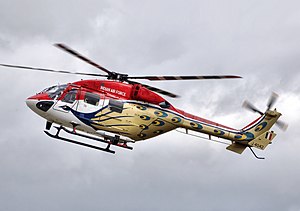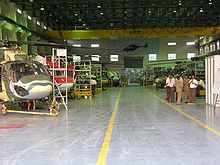The HAL Dhruv (Sanskrit: ध्रुव, "Polaris") is a utility helicopter developed and manufactured by India's Hindustan Aeronautics Limited (HAL). It is being supplied to the Indian Armed Forces, and a civilian variant is also available. The helicopter was first exported to Nepal and Israel, and is on order by several other countries for both military and commercial uses. Military versions in production are for transport, utility, reconnaissance and MedEvac roles.
Based on the Dhruv platform, the HAL Light Combat Helicopter (LCH) a helicopter gunship and HAL Light Observation Helicopter (LOH) a utility and observation helicopter were developed.
| Dhruv | |
|---|---|
| Dhruv helicopter of the Indian Air Force SarangHelicopter Display Team arriving at RIAT 2008,England. | |
| Role | Multirole helicopter |
| National origin | India |
| Manufacturer | Hindustan Aeronautics Limited |
| First flight | 20 August 1992 |
| Introduced | 2002 |
| Status | Active |
| Primary users | Indian Army Indian Air Force Indian Navy Ecuadorian Air Force |
| Number built | 105 [1] |
| Unit cost | |
| Developed into | HAL Light Combat Helicopter |
Development
Hindustan's Advanced Light Helicopter (ALH) program was first announced in November 1984, the ALH was designed with assistance from MBB in Germany. The twin 1000 shp Turbomeca TM333-2B turboshafts are mounted above the cabin and drive a four-blade composite main rotor. The ALH makes use of an advanced integrated dynamic system which combines several rotor control features into an integrated module. The civil prototype ALH (Z-3182) first flew on 23 August 1992, at Bangalore, followed by a second civil aircraft (Z-3183), an Army version (Z-3268) and a navalised prototype (N.901) with Allied Signal CTS800 engines and a retractable tricycle undercarriage. Even after the first prototype flew in August 1992, problems arose due to the changing demands of the Indian military, funding shortage in the wake of the 1991 India economic crisis, and contractual issues with Messerschmitt-Bölkow-Blohm, which was the consultant for design. Further delay was caused by U.S. sanctions following Indian nuclear tests in 1998, which embargoed the engine originally intended to power the helicopter. The helicopter then had to use the Turbomeca TM 333-2B2 turboshaft producing 746 kW (1000 shp) each, and an agreement was signed with Turbomeca to develop a more powerful engine. The first test flight of the Dhruv with the new Shakti engine took place on 16 August 2007.[3][4]
A variant of the Dhruv is the Dhruv-WSI (Weapons Systems Integrated) which arms the Army variant with anti-tank and anti-aircraft missiles and a 20-mm turret mounted cannon.
In addition to Dhruv-WSI, HAL is also developing the Light Combat Helicopter (LCH) based on the Dhruv platform for the Indian Armed Forces. The armored LCH will feature stub wings fitted to carry up to eight anti-armour missiles, four air-to-air missiles or four rocket pods for 70mm and 68mm rockets. The LCH will also have FLIR (Forward Looking Infrared), CCD (Charge Coupled Device) camera and a target acquisition system with thermal sight and laser rangefinder.
The first five Dhruv Mk III, the production version featuring the more powerful Shakti engine, were handed over to the Leh-based 205 Aviation Squadron on 07 Feb 2011,[5] at a ceremony at HAL's Helicopter Division, Bengaluru in which Major General P.K. Bharali represented Army Aviation.
Design
HAL Dhruv is of conventional design. About two-thirds of its empty weight features composite materials and construction. The high tail boom allows easy access to the rear clamshell loading doors. The four-bladed hingeless main rotor can be manually folded. The blades are mounted between cruciform-shaped carbon-fibre-reinforced plastic plates on a fibre elastomer constructed rotor head. The helicopter is equipped with an active vibration control system developed by Lord Corporation of North Carolina that uses sensors to monitor on-board conditions and outputs signals to actuators to cancel fuselage floor vibrations.
Dhruv's Integrated Dynamic System (IDS), which carries power from the Shakti engine to the helicopter’s rotors, was found to suffer from excessive wear and tear, requiring replacement at frequent intervals. HAL claimed to have fixed this for the Dhruv Mk III by making 6 modifications. Italian aerospace company, Avio, was hired to independently audit the wear-and-tear following the modifications.
Cockpit
The cockpit section of the fuselage is of Kevlar and carbon-fibre construction and is fitted with crashworthy seats. The aircraft is equipped with a SFIM Inc four-axis automatic flight control system. The navigation suite includes a global positioning system, a Doppler navigation system, distance measuring equipment, a true air speed indicator, automatic direction finder, a heading reference system, radio altimeter, VHF omnidirectional ranger and instrument landing system (VOR/ILS) and marker beacons. The communications suite includes HF, UHF, and VHF radio communications.
Military service
Deliveries of the Dhruv commenced in 2002, a full ten years after the prototype's first flight, and nearly twenty years after the program was initiated. The Indian Coast Guardbecame the first service to bring Dhruv helicopters into service. This was followed by the Indian Army, Indian Navy, Indian Air Force and the Border Security Force. 75 Dhruvs were delivered to the Indian armed forces by 2007 and the plan is to produce 40 helicopters yearly.
One of only three helicopter display teams in the world, the Sarang aerobatic display team of the Indian Air Force performs with 4 Dhruv helicopters.
The Dhruv is capable of flying at high altitudes, a crucial requirement for the Army, which requires helicopters for operations in Siachen Glacier and Kashmir. In September 2007, the Dhruv was cleared for high-altitude flying in the Siachen Sector after six-month long trials.[6][7] In October 2007, a Dhruv flew to an altitude of 27,500 feet (8,400 m) ASL in Siachen. This was the highest that the Dhruv had flown, and was higher than the 25,000 feet (7,600 m) record set by an IAF Cheetah helicopter in 2005.[8]
A further order for 166 helicopters were placed with HAL since the helicopter is working well in higher altitude areas with the Indian Army.[9] The Armed Forces may order 12 ambulances versions for use by the Armed Forces Medical Services for MEDEVAC operations . HAL Dhruv ambulances will have all the emergency medical equipment for the treatment of injured soldiers.[10]
In October 2008, the defence minister stated in the parliament that the Indian Navy will deploy the Dhruv in a Utility role. However, the anti-submarine version will not be pursued since it did not suit the Navy's requirements for the ASW role.[11]





0 comments:
Post a Comment